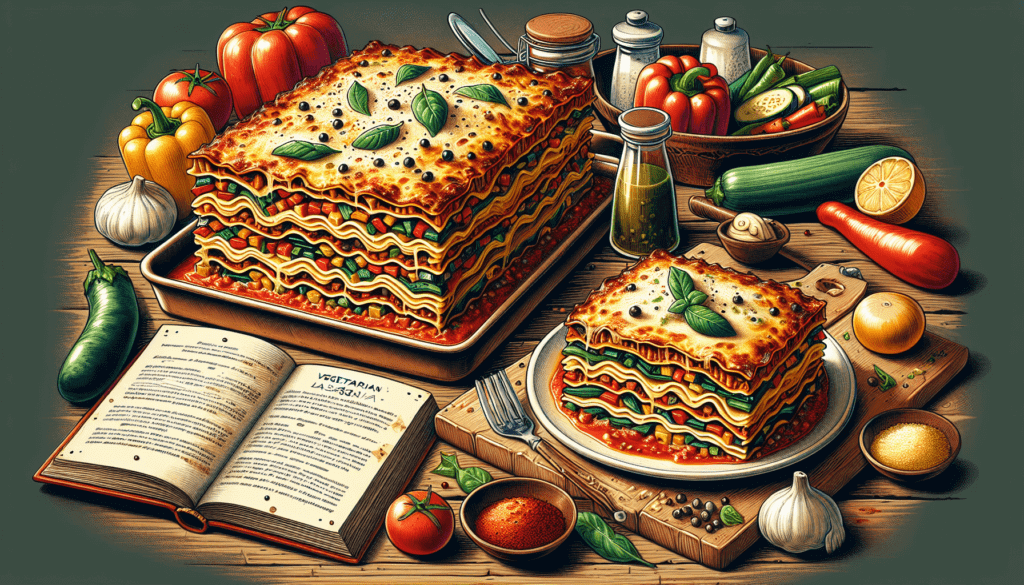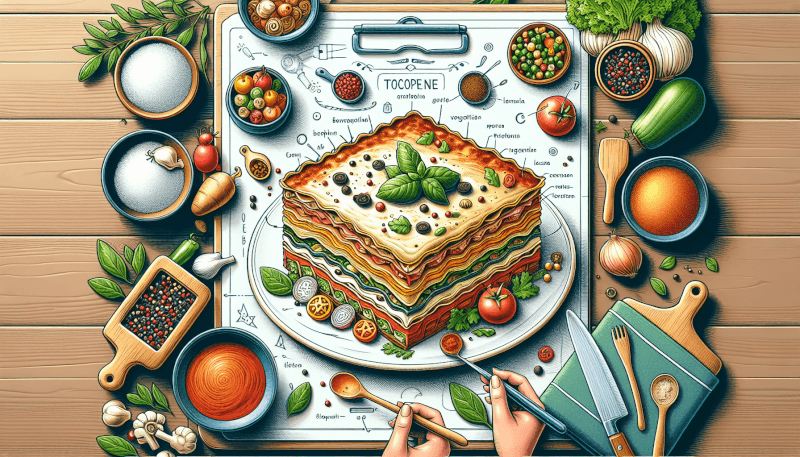Looking to make a delicious classic lasagna that will impress your family and friends? Look no further! In this article, we will share with you the top ways to create a mouthwatering lasagna that will have everyone coming back for seconds. Whether you prefer a meaty version or a vegetarian twist, we’ve got you covered. So roll up your sleeves and get ready to conquer the kitchen with these top techniques for making the best classic lasagna ever.
Choosing the Right Ingredients
When it comes to making classic lasagna, selecting the right ingredients is key to creating a delicious and satisfying dish. From the pasta sheets to the meat and cheese, each ingredient plays a vital role in the overall flavor and texture of the lasagna. Here are some tips to help you choose the perfect ingredients for your lasagna.
Selecting the Perfect Pasta Sheets
The foundation of any good lasagna is the pasta sheets. It’s important to choose ones that are sturdy enough to hold up to the layers of sauce, meat, and cheese, but still tender and flavorful. Look for pasta sheets specifically labeled for lasagna, as these tend to be the ideal size and thickness. If you prefer a more traditional lasagna, opt for dried pasta sheets, which will hold their shape and provide a hearty texture.
Using High-Quality Meat and Cheese
The meat and cheese in your lasagna are what will really elevate its flavor, so it’s worth investing in high-quality options. For the meat sauce, consider using a combination of ground beef and Italian sausage for a rich and savory flavor. Look for meats that are lean and have a good balance of fat for added flavor.
When it comes to cheese, the possibilities are endless. Opt for a combination of mozzarella, Parmesan, and ricotta cheese for a classic lasagna. Make sure to select high-quality cheeses with a rich flavor and smooth texture. Consider freshly grating the Parmesan cheese for an extra burst of flavor.
Choosing the Ideal Sauce
The sauce is what ties all the flavors together in a lasagna, so it’s important to choose one that complements the other ingredients. Consider making your own sauce using fresh tomatoes, garlic, onions, and herbs for a vibrant and flavorful base. Alternatively, opt for a high-quality store-bought sauce that is rich and full of depth.
Preparing the Meat
Preparing the meat for your lasagna is an essential step in creating a flavorful and satisfying dish. Follow these steps to ensure your meat is cooked to perfection and adds depth of flavor to your lasagna.
Selecting the Meat
When selecting the meat for your lasagna, choose options that are lean and have a good balance of fat. Ground beef and Italian sausage are both popular choices for a classic lasagna. Consider using a combination of the two for a rich and robust flavor profile.
Seasoning and Browning
To add depth of flavor to your meat sauce, it’s important to season and brown the meat before incorporating it into the recipe. Season the meat with salt, pepper, and any additional herbs and spices you prefer. Then, brown the meat in a skillet over medium heat until it’s fully cooked and has a nice golden color. This will help develop the flavors and create a rich and flavorful meat sauce.
Creating a Flavorful Meat Sauce
Once the meat is browned, it’s time to transform it into a flavorful meat sauce for your lasagna. Add diced onions, minced garlic, and your choice of herbs and spices to the skillet with the meat. Cook until the onions are translucent and the garlic is fragrant. Then, add your choice of tomato sauce or crushed tomatoes to the skillet and simmer for a few minutes to allow the flavors to meld together. Adjust the seasoning to taste and set aside until it’s time to assemble the lasagna.

Making the Cheese Filling
The cheese filling is what adds creaminess and richness to the layers of lasagna. Follow these steps to create a delicious and flavorful cheese filling for your lasagna.
Choosing the Cheese
The cheese filling can be made with a variety of cheeses, but for a classic lasagna, consider using a combination of mozzarella, Parmesan, and ricotta cheese. Mozzarella cheese provides a cheesy and gooey texture, while Parmesan adds a sharp and nutty flavor. Ricotta cheese adds a creamy and smooth texture to the filling. Consider using freshly grated Parmesan for added flavor.
Adding Herbs and Seasonings
To enhance the flavor of the cheese filling, consider adding herbs and seasonings. Fresh basil, oregano, and parsley are all traditional choices that pair well with the cheese. Finely chop the herbs and mix them into the cheese filling for a burst of freshness.
Mixing and Incorporating Ingredients
To create the cheese filling, mix the cheeses together in a bowl until well combined. Add the herbs and seasonings, as well as salt and pepper to taste. Stir until everything is evenly incorporated and set aside until it’s time to assemble the lasagna.
Building the Layers
Building the layers is where the magic happens in a lasagna. Follow these steps to achieve the perfect layers of pasta, meat sauce, and cheese filling.
Coating the Pan
Before adding any ingredients, it’s important to coat the baking pan with a thin layer of sauce. This will help prevent the lasagna from sticking to the pan and make it easier to serve. Use a spoon to spread a thin layer of sauce on the bottom of the pan, making sure to cover the entire surface.
Laying the First Layer of Pasta
Start by laying the first layer of pasta sheets on top of the sauce. Make sure they are slightly overlapping to create a solid base for the lasagna. Press them down lightly to remove any air bubbles and ensure even distribution of ingredients.
Spreading the Meat Sauce
After the pasta sheets, spread a generous layer of meat sauce over the pasta. Use a spoon or spatula to spread it evenly, making sure to cover the entire surface. This will provide a rich and hearty layer in the lasagna.
Adding the Cheese Filling
Next, add dollops of the cheese filling on top of the meat sauce. Use the back of a spoon to spread it out evenly and ensure it covers the entire surface. The cheese filling will add creaminess and richness to the lasagna.
Adding Another Layer of Pasta
Repeat the process of layering pasta sheets, meat sauce, and cheese filling until you have used all the ingredients. Aim for at least three layers, but you can add more if desired. Make sure to end with a layer of pasta sheets on top.
Repeating the Layers
Continue repeating the process of layering pasta, meat sauce, and cheese filling until you have used all the ingredients. Each layer will add depth of flavor and create a hearty and satisfying lasagna.

Finishing Touches
The finishing touches on a lasagna can make all the difference in terms of flavor and presentation. Follow these steps to add the final touches to your lasagna.
Topping with Mozzarella Cheese
Before baking the lasagna, sprinkle a generous amount of mozzarella cheese on top. The cheese will become golden and bubbly as it bakes, adding a deliciously gooey and cheesy layer to the lasagna.
Sprinkling Parmesan Cheese
After the mozzarella cheese, sprinkle a dusting of Parmesan cheese on top. This will add a nutty and salty flavor to the lasagna, as well as provide a crispy crust on top.
Covering with Sauce
To ensure the lasagna stays moist and flavorful, cover it with a layer of sauce before baking. This will prevent the top layer of pasta from drying out and create a delicious saucy layer on top.
Adding a Final Layer of Pasta
After covering the lasagna with sauce, add a final layer of pasta sheets on top. This will help seal in the flavors and create a sturdy top layer for the lasagna.
Sprinkling Extra Herbs
For an extra pop of freshness and flavor, sprinkle some additional herbs on top of the lasagna. Finely chop fresh basil, oregano, or parsley and scatter it evenly over the top layer of pasta.
Covering with Foil
To prevent the top layer of pasta from drying out and to allow the flavors to meld together, cover the lasagna with foil before baking. This will create a moist and tender lasagna that’s bursting with flavor.
Baking and Setting
Baking and setting the lasagna is a crucial step in achieving the perfect texture and flavor. Follow these steps to ensure your lasagna is cooked to perfection.
Preheating the Oven
Before baking, preheat the oven to a moderate temperature of around 350°F (180°C). This will ensure that the lasagna cooks evenly and that the cheese melts to a gooey and bubbly perfection.
Baking Time and Temperature
The baking time and temperature will vary depending on your specific recipe and oven. As a general guideline, bake the lasagna covered with foil for about 30 minutes, then remove the foil and bake for an additional 20-30 minutes, or until the top is golden and bubbly.
Checking for Doneness
To check if the lasagna is done, insert a sharp knife into the center of the dish. If it comes out clean and the pasta is tender, the lasagna is ready to be removed from the oven. If the knife is still slightly wet with sauce and the pasta is firm, continue baking for a few more minutes.
Allowing to Rest
Once the lasagna is done baking, it’s crucial to allow it to rest for at least 10-15 minutes before serving. This will help the lasagna set and make it easier to cut into perfect portions. The resting time will also allow the flavors to meld together and ensure a delicious and cohesive lasagna.

Serving and Garnishing
Serving and garnishing the lasagna is the final step in creating a beautiful and satisfying dish. Follow these steps to serve your lasagna like a pro.
Cutting into Perfect Portions
Use a sharp knife to cut the lasagna into perfect portions. Start by cutting along the edges of the dish to create even slices. Use a spatula to carefully lift each portion onto a plate.
Plating and Presentation
When plating the lasagna, make sure to arrange it neatly on the plate. Opt for a wide-rimmed pasta plate or a rectangular serving dish for an elegant presentation. Place a portion of lasagna in the center of the plate and garnish as desired.
Garnishing with Fresh Basil Leaves
For an extra touch of freshness and color, garnish the lasagna with fresh basil leaves. This will add a vibrant pop of green and a subtle hint of herbaceous flavor.
Accompanying Sides
To complete the meal, consider serving the lasagna with some accompanying sides. A simple green salad or garlic bread are both excellent choices that complement the flavors of the lasagna. Serve the sides on the same plate or on separate dishes for a well-rounded and satisfying meal.
Variations and Additions
While the classic lasagna recipe is delicious on its own, there are plenty of variations and additions you can try to customize the dish to your liking. Here are some ideas to inspire your creativity in the kitchen.
Veggie Lasagna
For a vegetarian twist on the classic lasagna, replace the meat with a variety of vegetables such as zucchini, mushrooms, spinach, and bell peppers. Sauté the vegetables beforehand to release their flavors and remove excess moisture. Layer them with the pasta sheets, cheese filling, and sauce for a hearty and flavorful veggie lasagna.
Seafood Lasagna
If you’re a fan of seafood, consider incorporating it into your lasagna for a unique and delicious twist. Opt for a combination of shrimp, scallops, and white fish for a seafood medley. Sauté the seafood with garlic and herbs before layering it into the lasagna. Top it off with a creamy white sauce made from a combination of Alfredo sauce and Parmesan cheese for a decadent and indulgent seafood lasagna.
Adding Spinach or Kale
For an extra burst of nutrition and flavor, add some greens to your lasagna. Spinach or kale are excellent choices that pair well with the cheese and sauce. Simply sauté the greens until wilted and layer them into the lasagna along with the other ingredients. This will add a vibrant pop of color and a subtle hint of freshness to the dish.
Incorporating Mushrooms
Mushrooms add a rich and earthy flavor to lasagna, making them a great addition for mushroom lovers. Sauté a variety of mushrooms such as cremini, shiitake, and portobello with garlic and onions before layering them into the lasagna. The mushrooms will add a meaty texture and depth of flavor to the dish.
Experimenting with Different Cheeses
While mozzarella, Parmesan, and ricotta are classic choices for lasagna, don’t be afraid to experiment with different cheeses to create unique flavor profiles. Consider using a combination of Gruyere, Fontina, and Gorgonzola for a gourmet twist. The cheeses you choose will dictate the overall flavor and texture of the lasagna, so have fun and get creative with your cheese selection.

Tips and Tricks
Making classic lasagna can be a rewarding and enjoyable experience. Here are some tips and tricks to help you achieve a delicious and perfect lasagna every time.
Cooking the Pasta Sheets Al Dente
To ensure the pasta sheets retain their shape and texture in the lasagna, cook them al dente before layering them into the dish. Al dente means the pasta is slightly firm to the bite and will continue to cook further in the oven. This will prevent the pasta from becoming mushy and overcooked in the final dish.
Allowing the Lasagna to Set Before Cutting
After removing the lasagna from the oven, it’s important to allow it to set and cool slightly before cutting into it. This will help the layers hold together and make it easier to cut neat and clean portions. The lasagna will be easier to handle and serve after it has set for about 10-15 minutes.
Letting the Lasagna Rest Before Serving
Once the lasagna has been cut into portions, it’s a good idea to let it rest for a few minutes before serving. This will allow the flavors to meld together and create a cohesive and delicious lasagna. The resting time will also make it easier to serve and enjoy the lasagna without everything falling apart.
Covering the Lasagna for Moisture
Covering the lasagna with foil while baking will help retain moisture and prevent the top layer of pasta from drying out. It’s also a good idea to cover any leftover portions with foil when reheating to maintain the moisture and prevent the lasagna from becoming dry.
Using Fresh Herbs for Enhanced Flavor
When it comes to herbs, using fresh herbs is always preferable for the best flavor. Fresh basil, oregano, and parsley are all excellent choices for lasagna. Finely chop the herbs just before using them to release their flavors and add an extra burst of freshness to the dish.
Make-Ahead Options
Lasagna can be a time-consuming dish to prepare, but there are make-ahead options that can help streamline the process. Here are some tips for making lasagna ahead of time.
Freezing the Lasagna
Lasagna is an excellent dish to freeze, as it holds up well and reheats beautifully. Once the lasagna is assembled and before baking, cover it tightly with foil and plastic wrap, then place it in the freezer. It can be frozen for up to 3 months. When ready to bake, remove the lasagna from the freezer and let it thaw in the refrigerator overnight. Bake according to the recipe’s instructions.
Reheating Instructions
To reheat a frozen or refrigerated lasagna, preheat the oven to 350°F (180°C) and cover the lasagna with foil. Bake for about 45-60 minutes, or until the lasagna is heated through and the cheese is bubbly. To ensure the lasagna stays moist, add a splash of water or sauce to the dish before reheating. Allow the lasagna to rest for a few minutes before serving.
Making classic lasagna requires some time and effort, but the end result is well worth it. By choosing the right ingredients, preparing the meat and cheese fillings, building the layers with care, and following some helpful tips and tricks, you can create a delicious and satisfying lasagna that will impress everyone at your table. Whether you stick to the classic recipe or add your own variations and additions, making lasagna is a delightful culinary adventure that is sure to bring joy to both the cook and the lucky diners. Bon appétit!



